Abstract
Background: Nowadays, the resistance to available antibiotics could be mentioned as a global threat to public health. The aim of this preliminary study was to conduct a retrospective survey associated with the prevalence of Nosocomial Infections (NIs) and the pattern of microbial resistance in a tertiary care referral hospital (Alzahra), Isfahan, Iran.
Methods: The data between the years 2016 to 2022 were extracted from the official database of hospital NI records. The microbiological culture results, represented by non-repetitive specimens, were further analyzed for pathogens and the pattern of antibiotic resistance. Then antibiotic susceptibility testing was done using standard methods of disk diffusion or Phoenix M50. The recorded variables have been presented as mean ± standard deviation, prevalence, and percentage. Data were analyzed using SPSS version 20.
Results: For a duration of 5.5 years, the period prevalence of NIs was recorded as 2%, with more than 50% associated with ventilator-associated events and urinary tract infections. Klebsiella pneumonia, Acinetobacter baumannii, and Staphylococcus were the main pathogens. Further study of specimens from the year 2022 (n= 898) confirmed the most isolated bacteria as Klebsiella pneumonia (n = 290, 32%), Acinetobacter baumannii (n= 206, 23%), Enterococcus (faecium-fecalis n=125, 14%), Escherichia coli (n = 116, 13%), Staphylococcus aureus (n = 95, 11%), and Pseudomonas aeruginosa (n = 66, 7%). Resistance (R%) in Isfahan versus the whole country was confirmed for Klebsiella pneumonia (third or fourth generation of cephalosporins: R = 80.9 vs. 82%), fluoroquinolones (R = 76.6 vs. 73%), beta-lactamase inhibitors (R = 75 vs. 79%), carbapenems (R = 65.7 vs. 66%), and so on, respectively.
Conclusion: There has been reported an increase in the proportion of isolates resistant to cephalosporins, fluoroquinolones, and others. The variety of latent pathogens resistant to frequently administered antibiotics highlights the significance of continued and homogenous antimicrobial evidence-based pharmacotherapy investigations in Isfahan, Iran. Further studies in this direction are recommended.
New Emirates Medical Journal
Title:Prevalence of Nosocomial Infections and the Pattern of Microbial Resistance in a Tertiary Care Referral Hospital (Alzahra), Isfahan, Iran
Volume: 5
Author(s): Zahra Tolou-Ghamari*, Arezoo Pourdad, Zahra Foroughi, Behrooz Ataei and Abbas Ali Palizban
Affiliation:
- Nutrition and Food Security Research Center, Deputy of Research and Technology, Isfahan University of Medical Sciences, Isfahan, Iran
Abstract:
Background: Nowadays, the resistance to available antibiotics could be mentioned as a global threat to public health. The aim of this preliminary study was to conduct a retrospective survey associated with the prevalence of Nosocomial Infections (NIs) and the pattern of microbial resistance in a tertiary care referral hospital (Alzahra), Isfahan, Iran.
Methods: The data between the years 2016 to 2022 were extracted from the official database of hospital NI records. The microbiological culture results, represented by non-repetitive specimens, were further analyzed for pathogens and the pattern of antibiotic resistance. Then antibiotic susceptibility testing was done using standard methods of disk diffusion or Phoenix M50. The recorded variables have been presented as mean ± standard deviation, prevalence, and percentage. Data were analyzed using SPSS version 20.
Results: For a duration of 5.5 years, the period prevalence of NIs was recorded as 2%, with more than 50% associated with ventilator-associated events and urinary tract infections. Klebsiella pneumonia, Acinetobacter baumannii, and Staphylococcus were the main pathogens. Further study of specimens from the year 2022 (n= 898) confirmed the most isolated bacteria as Klebsiella pneumonia (n = 290, 32%), Acinetobacter baumannii (n= 206, 23%), Enterococcus (faecium-fecalis n=125, 14%), Escherichia coli (n = 116, 13%), Staphylococcus aureus (n = 95, 11%), and Pseudomonas aeruginosa (n = 66, 7%). Resistance (R%) in Isfahan versus the whole country was confirmed for Klebsiella pneumonia (third or fourth generation of cephalosporins: R = 80.9 vs. 82%), fluoroquinolones (R = 76.6 vs. 73%), beta-lactamase inhibitors (R = 75 vs. 79%), carbapenems (R = 65.7 vs. 66%), and so on, respectively.
Conclusion: There has been reported an increase in the proportion of isolates resistant to cephalosporins, fluoroquinolones, and others. The variety of latent pathogens resistant to frequently administered antibiotics highlights the significance of continued and homogenous antimicrobial evidence-based pharmacotherapy investigations in Isfahan, Iran. Further studies in this direction are recommended.
Export Options
About this article
Cite this article as:
Tolou-Ghamari Zahra*, Pourdad Arezoo, Foroughi Zahra, Ataei Behrooz and Palizban Ali Abbas, Prevalence of Nosocomial Infections and the Pattern of Microbial Resistance in a Tertiary Care Referral Hospital (Alzahra), Isfahan, Iran, New Emirates Medical Journal 2024; 5 : e02506882306922 . https://dx.doi.org/10.2174/0102506882306922240603081511
| DOI https://dx.doi.org/10.2174/0102506882306922240603081511 |
Print ISSN 0250-6882 |
| Publisher Name Bentham Science Publisher |
Online ISSN 0250-6882 |

- Author Guidelines
- Bentham Author Support Services (BASS)
- Graphical Abstracts
- Fabricating and Stating False Information
- Research Misconduct
- Post Publication Discussions and Corrections
- Publishing Ethics and Rectitude
- Increase Visibility of Your Article
- Archiving Policies
- Peer Review Workflow
- Order Your Article Before Print
- Promote Your Article
- Manuscript Transfer Facility
- Editorial Policies
- Allegations from Whistleblowers




























